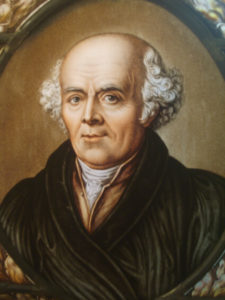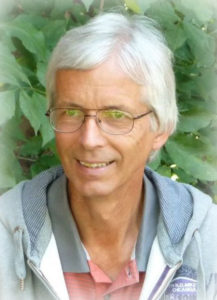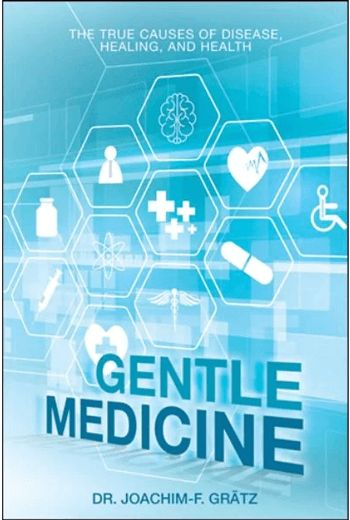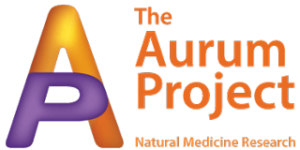Written by a Doctor who practices homeopathy, this comprehensive explanation references the work of Hahnemann and discusses acute and chronic diseases and miasms. It is an excerpt from the book Gentle Medicine – The True Causes of Disease, Healing, and Health, 2021, Balboa Press, Bloomington, USA. Gentle Medicine creates a comprehensive awareness for a new dimension in medicine, a medicine of the future that can be a reality today.
Author Dr. Joachim-F. Grätz, Classical Homeopathy, Oberhausen i. Obb., Germany.
Homeopathy – Acute and Chronic Diseases – The Miasms
The main characteristic of acute diseases is their tendency to heal on their own. They have a destination and therefore a defined beginning and defined end, with or without treatment with medication or homeopathic remedies. In the case of chronic diseases, on the other hand, self-healing is not possible. The organism grants them unhindered access and cannot eliminate them on its own. Chronic diseases progress in phases; there are latent periods between relapses where symptoms flare up time and again “in a more or less modified form and with new symptoms”, i.e. increase in ailments “every few years”. In other words, chronic diseases don’t end until the individual dies.
But conventional medicine only sees a difference in duration between acute and chronic diseases. The Pschyrembel Clinical Dictionary defines an acute disease as a “sudden, fast, violent illness”, while a definition of chronic disease is understood as a “slowly developing and slowly progressing illness.” Homeopathy, however, not only sees this temporal dimension, but also the character and nature of the disease! The difference between acute and chronic diseases lies in how the organism reacts. And this is where the term miasms comes into play, as we will address in more detail below.
Miasms
Miasm means something like tainting, contamination, or contagion (infectious, contagious, spoiling) and describes what’s behind the superficial suffering. To better understand this critical concept of chronic homeopathy, let me explain it in more detail using a small memorable example. After all, a picture is worth a thousand words.
For example, let’s look at a child that suffers from ear infections as many as eight times a year. They have become so bad that the eardrum is already perforated and a yellow-green secretion pours out of the ears, often leaving stains on the child’s pillow. Unfortunately, such cases are common. There are several ways to help this child. The traditional and most common method is to administer an appropriate antibiotic that will immediately stop the inflammation so that the fever goes down and the pain subsides. Another, more naturopathic way to provide relief would be to use onion sachets, cantharidin compresses, calf wraps, teas, or other “ancient home remedies”. And, finally, there is the homeopathic method, in which the remedy most similar to the symptoms of the disease is sought and administered.

All of these methods have one thing in common: they treat the acute aspects of the disease, that is a medicine or remedy is administered to make the acute symptoms disappear as quickly as possible. Conventional medicine’s approach focuses primarily on the macro level and fights the fever, microbes such as streptococci, and pain. The remedies from nature’s treasure chest basically do the same as local, organ-specific methods, the only difference being that these remedies are more biodegradable and don’t have as many or hardly any side effects. (See footnote 1). It is only the homeopathic principle that sees the child’s organism as a whole. In addition to the superficial diagnosis of purulent otitis media, it also considers such things as the child’s levels of thirst and appetite, the level and type of fever (e.g. inflammatory fever), dry heat or sweating with fever, complexion, illness during teething, psychological symptoms such as extreme attachment and tearfulness or spitefulness paired with constant demands, extreme withdrawal, weakness, and need for rest, periods of agitation, and much more. Homeopathy will also look for the actual cause of the infection such as drafts or a cold caught during a visit to the local pool, to name just a few. Based on this information, the simile – the similar agent – is determined according to the principles of the similarity rule and administered in potentized form. (See footnote 2).
This will result in more or less fairly quick successful treatment and provide the child with relief from all of the acute pathological symptoms. However, there are also differences regarding these different acute treatments. While the local procedures are designed to suppress symptoms, merely mitigating the symptoms at best and therefore not really curing the disease, we can say that it is only the homeopathic approach that offers real healing in the acute sense. On the one hand, the procedure is very individual so that each patient receives the right remedy, which is also of a subtle nature and doesn’t contaminate the body with chemicals in order to avoid any undesirable side effects.
But the ear infections will almost certainly come back! After all, only the acute disease was treated in each case. The tendency to suffer from purulent otitis so frequently hasn’t been addressed, not even with the homeopathic approach! And this is where the term miasm comes into play. Because middle ear infections will only occur repeatedly if there is a suitable breeding ground for such diseases. This is what we mean by miasm. Miasm refers to something like the disease behind the diseases or the underlying chronic disease. In this case, there is a pronounced tubercular diathesis, a certain miasm that shouldn’t be confused with acute tuberculosis and which will be dealt with in more detail below. This is the miasm which must be eliminated. And this is exactly where the chronic approach of homeopathy takes the reins by eliminating miasms taking into account the individual symptoms of the patient. Lasting health can only be reestablished when, as in our case here, the tubercular diathesis has largely been cleared. A patient’s tendency to purulent otitis will decrease over time and will ultimately become a thing of the past, making acute treatments as described above no longer necessary. And that is exactly the chronic aspect of classical homeopathy that the book is about.
The basic ideas of Hahnemann’s miasmic theory
Hahnemann’s miasmic theory is where real homeopathy begins! This theory of chronic diseases really enables homeopaths to cure diseases that conventional medicine considers incurable. Modern academic and equipment-based medicine, along with the entire lineup of today’s pharmaceutical industry, is largely helpless against such diseases and tries to alleviate their symptoms with strong and extremely toxic substances. Patients will oftentimes pay for such relief with newly inflicted diseases that are caused by the many harmful side effects of the medications and treatments administered.

Dr Samuel Hahnemann (1755 – 1843)
Hahnemann published this new disease theory after 12 years of intensive research and verification on patients and after more than 30 years’ experience using similia to treat acute diseases in his five volumes “The Chronic Diseases” starting in 1828. Unfortunately, the work was not really understood by most homeopaths at the time and was therefore largely rejected and disregarded. This situation persists to this day. But practitioners who deny these laws and rules regarding chronic diseases should not really call themselves homeopaths (or “true healing artists”, as Hahnemann himself put it). These rules and laws go far beyond mere simile relationships and are fundamental to the classical homeopathic treatment of chronic ailments. By ignoring them, practitioners are missing out on many wonderful opportunities and will never experience homeopathy at its fullest. Homeopathy without the miasmic theory can only be rudimentary acute homeopathy, in other words, treatment that is merely palliative but does not deliver a permanent cure.
In “The Chronic Diseases”, Hahnemann himself came to the overwhelming conclusion that someone who is free from any miasms is absolutely healthy and can lead a life without disease and destruction; indeed, such a person can’t even catch a cold!
Historical perspective
Previous histories have claimed that the impetus for Hahnemann’s miasmic theory stemmed from the observation that the initial beneficial effect of the remedies administered in many cases of repeated acute treatments slowly became ineffective while the old pathological conditions or similar phenomena reoccurred over time, but with the difference that they became increasingly persistent and that the originally effective remedies no longer worked. After 12 years of intensive research into this question, Hahnemann concluded that one did not just have to address the current presentation of the disease, that it is not a self-contained event that should be treated as an independent disease, but rather as a separate part of an underlying basic ailment. In other words, the presenting symptoms are only the active part of a disease behind the diseases. It’s nothing more than the outward manifestation of inner suffering, the chronic upset of the vital force. Hahnemann called these background diseases, of which there are only a few, miasms.
However, according to more recent research by Gerhard Risch, the true beginnings of the miasmic theory go back much further than previously thought: As early as 1785, the founder of homeopathy was working with the two venereal (See footnote 3) diseases syphilis and gonorrhea and recognized them as chronic diseases. He already understood “chronic” to have the same meaning he would still be using in 1828: they are chronic because the body is unable to overcome them without intervention. Therefore, for Hahnemann, “chronic” had a diagnostic-qualitative dimension right from the start and not just a temporal one! “Chronic” describes the character of the disease and largely has nothing to do with its duration. Chronic diseases continue to increase and eventually lead to destruction. It was only about 40 years later that, in addition to the two venereal diseases, that he added psora, which he also describes as a chronic non-venereal disease. Hahnemann wasn’t even 34 years of age at the time and had yet to perform his famous self-experiment with Chinese bark, which is still celebrated worldwide as the birth of homeopathy. The claim that his theory of chronic diseases originated from a senile old brain, as opponents of the miasmic theory repeatedly argue, has thus turned out to be historical falsehood. The basics of this chronic disease theory were already certain before he rediscovered the law of similia and the resulting tests of his remedies on healthy subjects and all of acute homeopathy. In addition, it’s obvious that Hahnemann thought in terms of energy from the very beginning: in 1789, he had already recognized Mercurius solubilis as an anti-syphilitic agent, as published in his treatise on venereal diseases. The “mercurial fever” caused by the Mercurius solubilis is a kind of artificial disease that cures the actual disease of syphilis.
Risch’s logical conclusion thus gave the miasmic theory the status it deserves: “Homeopathy, therefore, began long before 1790 … and is much more than just the law of similia!”
About half a century later, Hahnemann’s most capable students discovered that miasms are also
hereditary-chronic, i.e. the potential to react pathologically in a certain way when certain conditions and prerequisites are met is passed on. Based on their many years of practical experience and meticulous observations, they left us with rules on how to recognize and treat these hereditary-chronic miasms in practice. In fact, the rules for treating such hereditary-chronic basic diseases are completely different from those that apply to the treatment of acquired miasms. Hahnemann was only able to teach us a part of what we have come to know about acquired miasms; already in his seventies, he was only at the brink of this groundbreaking theory. Specific statements about the homeopathic approach to hereditary miasms would have to wait until the work of
James Tyler Kent and especially
John Henry Allen, both active around the turn of the last century.
“Especially Allen has broadened and expanded Hahnemann’s miasmic theory by recognizing and formulating the nature and effect of miasms, their interaction with each other, and the effects of their suppression.” (
Dr. Andreas Gentner, pediatrician) Those who are not familiar with these findings or who do not use them therapeutically are limiting themselves and depriving their patients of the wonderful advances that are enabling the successful treatment of chronic diseases, especially in our time.
Characteristics of basic chronic diseases
The miasms, the diseases behind the diseases, can be characterized as follows:
- They are chronic and, from the perspective of conventional treatments, virtually incurable, wreaking a path of destruction that doesn’t end until the death of the patient.
- They feed on repeated flare ups in ever more central regions of the organism.
- If local measures fight and even suppress external manifestations of the diseases, they respond by getting worse.
Unlike acute diseases, the organism will grant chronic diseases unhindered access to the body. It cannot get rid of them on its own; self-healing is therefore not possible. Chronic diseases always progress in phases (stages) or occur as acute relapses with supposedly latent periods in-between that give the impression of healing and simulate supposed health. However, they do come back, sometimes only after months or even years, in a more or less modified form or even with a completely new disease pattern, mostly with symptoms that, from a conventional point of view, would not be remotely associated with the previous ones because they really have nothing to do with each other from a clinical point of view. This is how the miasm drives the organism on its path of destruction without being clearly perceptible to everyone.
Miasms are always passed on at the transmitter’s current stage. Contagion in the third stage of sycosis, for example, doesn’t mean acute gonorrhea, but mainly results in the symptoms of the tertiary stage of this destructive miasm, such as chronic sinusitis (sinus infections), rheumatism, gout, polyarthritis, hay fever, asthma, slowed responsiveness, irrational fears, depression, psychotic states, and much more.
Anti-miasmatic treatment
The first therapeutic consequence of this approach with regard to chronic diseases is that the individual stages of the disease in a person’s life are, under no circumstances, to be regarded as stand-alone, new, mutually independent diseases. As a matter of principle, they are considered an acute exacerbation of one or more active miasms, i.e. an acute flare-up of one or more chronic underlying conditions. This means that each symptom shouldn’t be treated separately, but that it’s important to remove the underlying chronic diseases step-by-step as a whole. Homeopathic treatment of chronic diseases is therefore anti-miasmatic in nature and is not aimed at the superficial symptoms of acute manifestations. Anti-miasmatic (See footnote 4) treatment goes beyond obvious visual cues and digs deeper by searching for the prima causa morbi, the most original cause of the disease, i.e. the underlying miasm.
Ban on local manipulation
The second therapeutic consequence concerns the so-called external manifestations. Any manipulation of the external symptoms of the disease with “external means” must be avoided Hahnemann strictly forbade any removals from the body, slathering it, or burning it with acids. He considered such treatments to be “a mortal sin at the hands of practitioners!”, because they drive the disease from the outside in where, from an energy point of view, it will only worsen (possibly even dramatically).
This can mean, for example, that “neurodermatitis will turn into a tendency to spastic bronchitis” or that a “flu will turn into a tendency to myocarditis or epileptic seizures” or “sinusitis will cause chronic rheumatism, e.g. in the form of polyarthritis”.
Everything that has been driven from the inside out, i.e. to the periphery of the organism, must therefore remain absolutely untouched because it is not the actual disease but only the body’s own measures to seek relief and offset an inner, deeper suffering. These were called local ailments by Hahnemann and they are an active attempt by the body to bring about a better interim state so that the miasms are unable to erupt with secondary or even later with tertiary symptoms. Removing a local ailment from the surface, which is in many cases the only visible sign of the chronic disease, can ultimately result in many chronic ailments and, according to Hahnemann, is “one of the most criminal acts that the medical profession is guilty of”. Any manipulation and “doctoring” of external symptoms is forbidden for any true healer!
Footnotes
- There is no such thing as side effects. Not really! There are only the effects of a substance or a combination of substances (medication). See the chapter 2.8.5 Drug miasm in the book Gentle Medicine – The True Causes of Disease, Healing, and Health).
- Potencies: By means of a special preparation, step-by-step, dynamic homeopathic medications. A rather complex topic of its own, which cannot be considered in detail at this point. For more information, see my book Die homöopathischen Potenzen – Ein Ratgeber aus der Praxis (The homeopathic potencies – A guide from a practitioner), 2003.
- Venereal: concerning an STD, acquired through sexual intercourse.
- The term anti-miasmatic has crept into homeopathic usage. It really should be properly called homeo-miasmatic, since homeopathy only works according to the principle of similia.
References
- Allen, J. H., The Chronic Miasms, 1921, Reprint Edition 2006, B. Jain Publishers Pvt. Ltd., New Dehli
- Grätz, Dr. Joachim-F., Gentle Medicine – The True Causes of Disease, Healing, and Health, 2021, Balboa Press, Bloomington, USA
- Hahnemann, S., The Chronic Disaeses, 1896, Philadelphia, Boericke & Tafel
- Kent, J. T., Lectures on Homoeopathic Philosophy, 5th Edition 1954, Reprint Edition 1989, B. Jain Publishers Pvt. Ltd., New Dehli
- Risch, G., Die Anfänge der Miasmen-Lehre Hahnemanns, Naturheilpraxis, journal 2/1995, Pflaum Verlag, München
- Risch, G., Die hereditär-chronischen Miasmen, Naturheilpraxis, journal 12/1996, Pflaum Verlag, München
About the Author

Author Dr. Joachim-F. Grätz
Dr. Joachim-F. Grätz, Germany, has been working very successfully as a classical homeopath for over 30 years, taking into account the so-called miasms (chronic basic diseases, disease behind the diseases) and is known far beyond the borders of Germany. The uniqueness of his form of therapy consists in his holistic worldview whereby he also integrates insights from dealing with other natural laws into his homeopathic thinking. This enables him to recognize the causal relationships of every illness and to treat them accordingly. An extraordinarily successful practitioner, even with the most severe diseases.
Dr. Grätz studied homeopathy with the well-known German homeopath Dr. Otto Eichelberger in Munich, who was one of the first to take the miasms into account in therapy and who made the LM-potencies (Q-potencies) public in the German-speaking countries. He attended seminars of Gerhard Risch, Dr. Mohinder Singh Jus, Prof George Vithoulkas, Dr. Michael Barthel, Yves Laborde, Dr. Rajan Sankaran and Paul Herscu and got acquainted with different directions of homeopathy.




